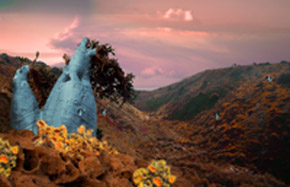By Jane Eastwood, XRI Lead Exobiologist
Exploring a different biosphere means reevaluating many of the things biology takes for granted. Confining our searches to relatively Earth-similar planets means that potential organisms will very likely have some similarities—but if there is life, we expect it to be totally unlike what we are familiar with.
A series of accidents and quirks of geology, climate, and geography made Earth's organisms what they are today. Without the high carbon dioxide levels during the Devonian (probably caused by volcanoes), land plants would not have become gloriously diverse. The Permian-Triassic extinction event (and probable asteroid impact) allowed seed-bearing plants and mammals to proliferate and the first endosymbiotic events seem to be pure fortuitous accidents.
We are assuming that there will be some constants in life on a foreign planet. First and foremost, life will need to obtain and consume some sort of energy. Whether the source of the energy is heat from the planet's core, chemical reactions from the rocks, nutrients gained from consuming other life forms, or good old-fashioned photosynthesis, organisms must somehow harvest energy to grow and reproduce. We expect amazing discoveries in how life finds a way—life forms could even potentially have tiny windmills to harvest energy from the air itself!
As the last paragraph indicates, we are also expecting any life we might find to grow and reproduce. There might be a single cell adrift in the sea or sitting on a rock that feels no need to do either, but it's terribly unlikely that we'll manage to find such an organism. Since our target planet has liquid water, other likely constants are carbon-based and water-lubricated life. Water is the best solvent known to man—life without osmotic differences and nutrients in solution is almost inconceivable—and at the temperatures we've measured, no other liquid comes close. Similarly, carbon-based life is likely because of carbon's ability to form up to four bonds with many other elements. We're also expecting much—if not all—of the organisms that we encounter to be unicellular, and by extension, cellular. We are unsure of the circumstances that lead to multi-cellular life, but it seems to have happened rarely, and under very specific circumstances. Expecting the same circumstances on a different planet is optimistic. As for our belief that life will be similar to cellular life, we're not expecting a lipid bilayer or DNA. It's just that we aren't likely to recognize something as living unless there's some barrier between it and the surrounding world and something that can carry instructions for replication. The only other way we'd call something alive is if it handed us a note.
Speaking of intelligent life—it is unlikely that there is anything remotely intelligent on this planet. If there were, the odds that we would recognize it as such are similarly remote. If you joined this project because of your pressing need to communicate with other life forms, please set up a successful colloquium with the roaches in your kitchen first.
Even a process as familiar as photosynthesis could be changed by a different evolutionary history. On Earth, only one molecule—chlorophyll a—is capable of capturing photons and transferring that energy into a chemical form, but pseudo-plants on other planets might not be so constrained. If new molecules can perform photosynthesis, then vegetation might not be mostly green. Instead, the color of the new photosynthetic molecules will tint the vegetation—potentially giving landscapes that are brilliant blues or oranges.
Even though we expect Epsilon Eridani e to have a climate roughly similar to Earth's, the weather could be unlike anything we've ever encountered—and small differences could lead to big differences in life forms. On Earth, limited access to water has shaped all of the organisms that live on land. Trees devote about a third of their biomass to obtaining water, most plants leak sugars into the soil to recruit fungi to collect water for them, and animals have exoskeletons or skins to keep their insides in and appropriately lubricated. Habitats on Earth with little water have insects, amphibians, and fish that bury their eggs deep underground, where they potentially wait years for the next rain. Plants either adopt extreme conservation methods—collecting CO2 only after dark, excreting a thick waxy cuticle—or they too become ephemeral, living through the dry spells as desiccated, apparently dead debris, or sleeping as seeds. Those habitats with more water are flush with many many organisms, all competing for that precious resource—thus the image of the beautiful oasis, alive with palms, flowers, birds, and game.
Thus far I've talked about how life might change if a stressor from Earth were absent—we can't begin to imagine all of the stresses this planet might possess, or how life forms have adapted. We hope that Epsilon Eridani e will offer a fraction of the diversity of Earth's biome. If there is life, the ways that it differs from the life we know will teach us more about biology than we ever imagined. But beyond that is the irresistible desire to explore, to categorize, and to understand new things—these traits are the finest part of being human. (According to this biologist, anyway.) I hope that you'll join us as we open up this new world—and discover all the wondrous creatures in it.

